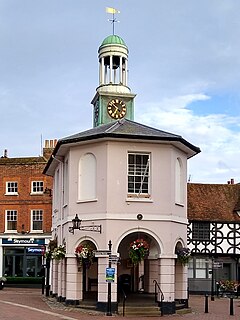
Back قودالمینق AZB Godalming (kapital sa parokya) CEB Godalming Czech Godalming Welsh Godalming German Godalming Spanish Godalming Basque گودالمینگ Persian Godalming French Godalming Irish
| Godalming | |
|---|---|
| Market town and civil parish | |
 The Pepperpot, High Street | |
Location within Surrey | |
| Area | 9.68 km2 (3.74 sq mi) |
| Population | 21,804 (civil parish 2011)[1] or 22,689 (built-up area)[2] |
| • Density | 2,252/km2 (5,830/sq mi) |
| OS grid reference | SU968437 |
| • London | 30 mi (49 km) NE |
| Civil parish |
|
| District | |
| Shire county | |
| Region | |
| Country | England |
| Sovereign state | United Kingdom |
| Post town | Godalming |
| Postcode district | GU7 |
| Dialling code | 01483 |
| Police | Surrey |
| Fire | Surrey |
| Ambulance | South East Coast |
| UK Parliament | |
Godalming (/ˈɡɒdəlmɪŋ/ GOD-əl-ming) is a market town and civil parish in southwest Surrey, England, around 30 miles (49 km) southwest of central London. It is in the Borough of Waverley, at the confluence of the Rivers Wey and Ock. The civil parish covers 3.74 sq mi (9.7 km2) and includes the settlements of Farncombe, Binscombe and Aaron's Hill. Much of the area lies on the strata of the Lower Greensand Group and Bargate stone was quarried locally until the Second World War.
The earliest evidence of human activity is from the Paleolithic and land above the Wey floodplain at Charterhouse was first settled in the middle Iron Age. The modern town is believed to have its origins in the 6th or early 7th centuries and its name is thought to derive from that of a Saxon landowner. Kersey, a woollen cloth, dyed blue, was produced at Godalming for much of the Middle Ages, but the industry declined in the early modern period. In the 17th century, the town began to specialise in the production of knitted textiles and in the manufacture of hosiery in particular.
Throughout its history, Godalming has benefitted from its location on the main route from London to Portsmouth Dockyard. Local transport links were improved from the early 18th century with the opening of the turnpike road through the town in 1749 and the construction of the Godalming Navigation in 1764. Expansion of the settlement began in the mid-19th century, stimulated by the opening of the first railway station in 1849 and the relocation of Charterhouse School from London in 1872. The town has a claim to be the first place in the world to have a combined public and private electricity supply.
Several buildings in the town centre date from the 16th and 17th centuries. The distinctive Pepperpot was built in 1814 to replace the medieval market house and to house the council chamber. Among the notable former residents of the civil parish were Jack Phillips, the senior wireless operator on the RMS Titanic, and the mountaineer George Mallory. James Oglethorpe, the founder of the Colony of Georgia, was born in Godalming in 1696 and the town maintains a friendship with the U.S. state and the cities of Savannah and Augusta in particular.
- ^ Key Statistics; Quick Statistics: Population Density Archived 6 January 2009 at the Wayback Machine United Kingdom Census 2011 Office for National Statistics Retrieved 21 November 2013
- ^ UK Census (2011). "Local Area Report – Godalming Built-up area sub division (1119884687)". Nomis. Office for National Statistics. Retrieved 23 February 2019.
